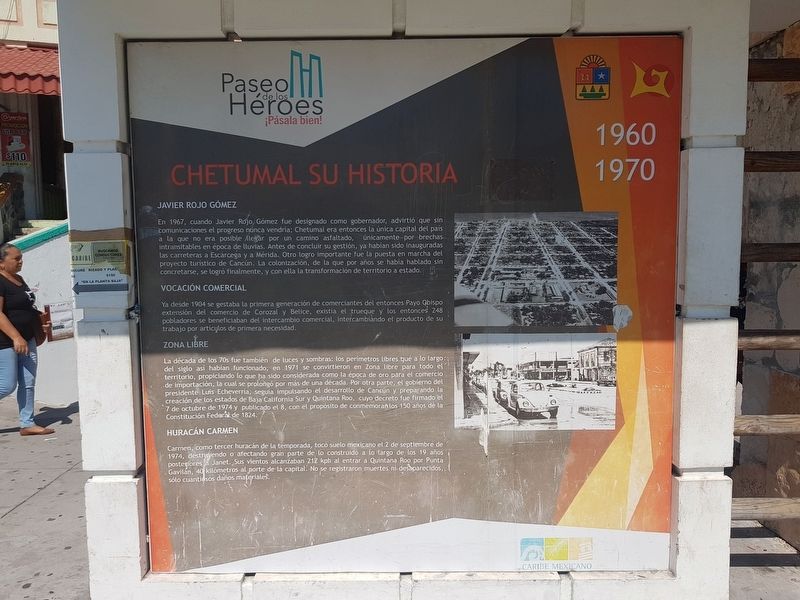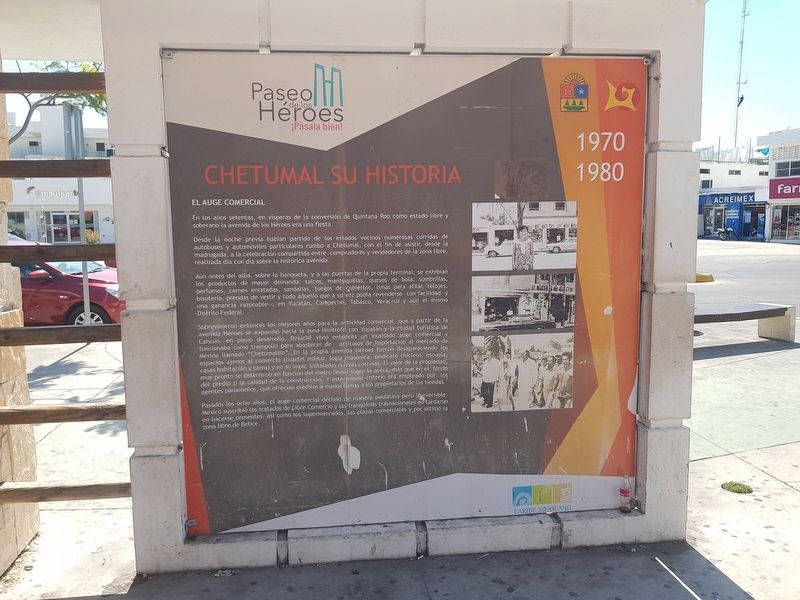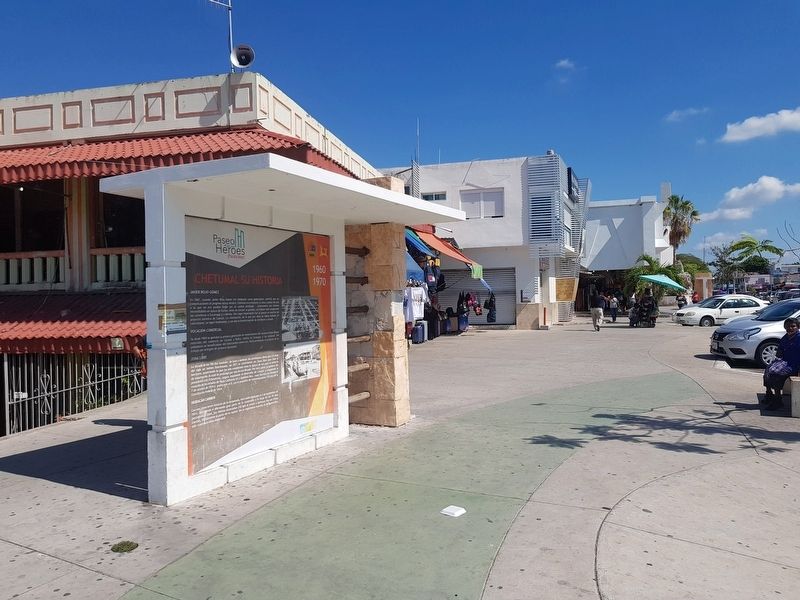Chetumal in Othón P. Blanco, Quintana Roo, Mexico — The Yucatan Peninsula (The Southeast)
The History of Chetumal: 1960-1970 and 1970-1980
Paseo de los Héroes
Inscription.
Javier Rojo Gómez
En 1967, cuando Javier Rojo Gómez fue designado como gobernador, advirtió que sin comunicaciones el progreso núnca vendria; Chetumal era entonces la única capital del país a la que no era posible llegar por un camino asfaltado, únicamente por brechas intransitables en época de lluvias. Antes de concluir su gestión, ya habían sido inauguradas las carreteras a Escárcega y a Mérida. Otro logro importante fue la puesta en marcha del proyecto turístico de Cancún. La colonización, de la que por años se había hablado sin concretarse, se logró finalmente, y con ella la transformación de territorio a estado.
Vocación Comercial
Ya desde 1904 se gestaba la primera generación de comerciantes del entonces Payo Obispo extensión del comercio de Corozal y Belice, existía el trueque y los entonces 248 pobladores se beneficiaban del intercambio comercial, intercambiando el producto de su trabajo por articúlos de primera necesidad.
Zona Libre
La década de los 70s fue también de luces y sombras: los perímetros libres que a lo largo del siglo así habían funcionado, en 1971 se convirtieron en Zona libre para todo el territorio, propiciando lo que ha sido considerada como la época de oro para el comercio de importación, la cual se prolongó por más de una década. Por otra parte, el gobierno del presidente Luis Echeverría, seguía impulsando el desarrollo de Cancún y preparando la creación de los estados de Baja California Sur y Quintana Roo, cuyo decreto fue firmado el 7 de octubre de 1974 y publicado el 8, con el propósito de conmemorar los 150 años de la Constitución Federal de 1824.
Huracán Carmen
Carmen, como tercer huracán de la temporada, tocó suelo mexicano el 2 de septiembre de 1974, destruyendo o afectando gran parte de lo construido a lo largo de los 19 años posteriores a Janet. Sus vientos alcanzaban 212 kph al entrar a Quintana Roo por Punta Gavilán, 40 kilómetros al norte de la capital. No se registraron muertes, ni desaparecidos, sólo cuantiosos daños materiales.
1970 1980
El Auge Comercial
En los años setentas, en vísperas de la conversión de Quintana Roo como estado libre y soberano la avenida de los Héroes era una fiesta.
Desde la noche previa habían partido de los estados vecinos numerosas autobuses y automóviles particulares rumbo a Chetumal, con el fin de asistir, desde la madrugada, a la celebración compartida entre compradores y vendedores de la zona libre, realizada día con día sobre
la histórica avenida.
Aún antes del alba, sobre la banqueta, y a las puertas de la propia terminal, se exhibían los productos de mayor demanda: talcos, mantequillas, quesos de bola, sombrillas, perfumes, carnes enlatadas, sandalias, juegos de cubiertos, limas para afilar, relojes, bisutería, prendas de vestir y todo aquello que a su vez podía revenderse con facilidad – y una ganancia razonable -, en Yucatán, Campeche, Veracruz y aún el mismo Distrito Federal.
Sobrevinieron entonces los mejores años para la actividad comercial, que a partir de la avenida Héroes se expandió hacia la zona limitrofé con Yucatán y la ciudad turística de Cancún, en pleno desarrollo. Dziuché vivió entonces un inusitado auge comercial y funcionaba como trampolín para abastecer de artículos de importación al mercado de Mérida llamado "Chetumalito". En la propia avenida Héroes fueron desapareciendo los espacios ajenos al comercio (cuartel militar, logia masónica, sindicato chiclero, escuela, casas habitación y otros) y en su lugar, instaladas nuevas cortinas. El valor de la propiedad, muy pronto se determinó en función del metro lineal sobre la acera, más que en el fondo del predio o la calidad de la construcción. Y este mismo criterio era empleado por los agentes panameños, que ofrecían créditos a manos llenas a los propietarios de las tienda.
Pasados los ocho años, el auge
comercial declinó de manera paulatina pero irreversible. México suscribió los tratados de Libre Comercio y las franquicias trasnacionales no tardaron en hacerse presentes, así como los supermercados, las plazas comerciales y por último la zona libre de Belice.
1960 1970
Javier Rojo Gómez
In 1967, when Javier Rojo Gómez was appointed governor, he warned that without communications, progress would never come; Chetumal was at that time the only capital of the country that was not possible to reach by a paved road, only by impassable gaps in the rainy season. Before concluding his administration, the roads to Escárcega and Mérida had already been inaugurated. Another important achievement was the start-up of the tourist project in Cancún. The colonization, of which for years it had been talked about without happening, was finally achieved, and with it the transformation from territory to state.
A Calling for Business
Since 1904 the first generation of merchants of the then Payo Obispo were an extension of the commerce between Corozal and Belize, where barter still existed and the original 248 inhabitants benefited from the commercial interchange, exchanging the product of their work for necessary products.
The Free Trade Zone
The decade of the 70s was one of highs and lows: the free trade zones that been in existence for almost a century were officially converted in 1971 into the whole territory becoming a Free Trade Zone, kicking off what has been considered as the golden age for import trade, which lasted for more than a decade. On the other hand, the government of President Luis Echeverría continued to promote the development of Cancún and preparations for the creation of the states of Baja California Sur and Quintana Roo, whose decree was signed on October 7, 1974 and published on the 8th, with the purpose of commemorating the 150th anniversary of the Federal Constitution of 1824.
Hurricane Carmen
Carmen, as the third hurricane of the season, touched Mexican soil on September 2, 1974, destroying or affecting much of that built throughout the 19 years after Hurricane Janet. Its winds reached 212 kph when it entered Quintana Roo by Punta Gavilán, 40 kilometers north of the capital. There were no deaths or missing persons, only significant material damage.
1970 1980
The Period of High Commercial Activity
In the seventies, on the eve of the conversion of Quintana Roo to a free and sovereign state, the Avenue of the Heroes was a constant party.
Since the previous night, numerous buses and cars had departed from the neighboring states towards Chetumal, with the aim of attending, from dawn, the shared celebration between Free Trade Zone buyers and sellers, held on the historic avenue.
Even before dawn, on the sidewalk, and at the doors of the terminal itself, the most demanded products were exhibited: talcum powders, butters, cheeses, umbrellas, perfumes, canned meats, sandals, sets of silverware, sharpening files, watches, jewelery, clothing and everything that could be resold easily - and a reasonable profit - in Yucatán, Campeche, Veracruz and even the Federal District itself.
Then came the best years for commercial activity, which, starting from the Avenida de los Héroes, expanded towards the border zone with Yucatán and the tourist city of Cancún, then in full development. Dziuché then experienced an unusual commercial boom and worked as a springboard to supply imported goods to the market of Mérida, known as "Chetumalito". On Avenida de los Héroes non-commerical properties began to disappear, for example the military zone, masonic lodge, chewing gum harvesters’s union building, schools, houses and others, and in their place, new businesses were installed. The value of property was soon determined based on the linear meter of sidewalk, rather than on the value of the property or the quality of construction. This same criterion was used by Panamanian agents, who offered loans to the owners of storefronts.
After eight years, the commercial boom declined gradually but irreversibly. Mexico signed free trade agreements and the transnational franchises were soon present in the area, as well as supermarkets, commercial plazas and finally the Free Zone with Belize.
Topics. This historical marker is listed in these topic lists: Industry & Commerce • Settlements & Settlers. A significant historical date for this entry is September 2, 1974.
Location. 18° 30.155′ N, 88° 17.751′ W. Marker is in Chetumal, Quintana Roo, in Othón P. Blanco. Marker is on Avenida de los Héroes just south of Mahatma Gandhi, on the right when traveling south. Touch for map. Marker is in this post office area: Chetumal QR 77000, Mexico. Touch for directions.
Other nearby markers. At least 8 other markers are within walking distance of this marker. La Chetumaleña (within shouting distance of this marker); Hospital Morelos (within shouting distance of this marker); Dimas Sansores (within shouting distance of this marker); Manuel Ignacio Altamirano Market (within shouting distance of this marker); The History of Chetumal: 1940-1950 (within shouting distance of this marker); Juventino Rosas Theater (within shouting distance of this marker); Archaeological Sites of Southern Quintana Roo (within shouting distance of this marker); Hurricane Janet (within shouting distance of this marker). Touch for a list and map of all markers in Chetumal.
Credits. This page was last revised on April 23, 2023. It was originally submitted on March 31, 2019, by J. Makali Bruton of Accra, Ghana. This page has been viewed 365 times since then and 55 times this year. Photos: 1, 2, 3. submitted on March 31, 2019, by J. Makali Bruton of Accra, Ghana.


